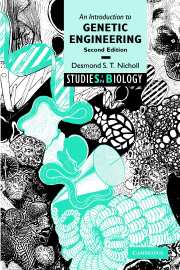Book contents
- Frontmatter
- Contents
- Preface to the second edition
- 1 Introduction
- Part I The basis of genetic engineering
- Part II The methodology of gene manipulation
- Part III Genetic engineering in action
- 9 Understanding genes and genomes
- 10 Genetic engineering and biotechnology
- 11 Medical and forensic applications of gene manipulation
- 12 Transgenic plants and animals
- 13 The other sort of cloning
- 14 Brave new world or genetic nightmare?
- Suggestions for further reading
- Using the World Wide Web
- Glossary
- Index
12 - Transgenic plants and animals
Published online by Cambridge University Press: 05 June 2012
- Frontmatter
- Contents
- Preface to the second edition
- 1 Introduction
- Part I The basis of genetic engineering
- Part II The methodology of gene manipulation
- Part III Genetic engineering in action
- 9 Understanding genes and genomes
- 10 Genetic engineering and biotechnology
- 11 Medical and forensic applications of gene manipulation
- 12 Transgenic plants and animals
- 13 The other sort of cloning
- 14 Brave new world or genetic nightmare?
- Suggestions for further reading
- Using the World Wide Web
- Glossary
- Index
Summary
The production of a transgenic organism involves altering the genome so that a permanent change is effected. This is different from somatic cell gene therapy, in which the effects of the transgene are restricted to the individual who receives the treatment. In fact, the whole point of generating a transgenic organism is to alter the germ line, so that the genetic change is inherited in a stable pattern following reproduction. This is one area of genetic engineering that has caused great public concern, and there are many complex issues surrounding the development and use of transgenic organisms. In addition, the scientific and technical problems associated with genetic engineering in higher organisms are often difficult to overcome. This is partly due to the size and complexity of the genome, and partly due to the fact that the development of plants and animals is an extremely complex process that is still not yet fully understood at the molecular level. Despite these difficulties, methods for the generation of transgenic plants and animals are now well established, and the use of transgenic organisms has already had a major impact in a range of different disciplines. In this chapter we will consider the development and use of transgenic plants and animals.
Transgenic plants
All life on earth is dependent on the photosynthetic fixation of carbon dioxide by plants. We sometimes lose sight of this fact, as most people are removed from the actual process ogfenerating our food, and the supemrarket shelves have all sorts of exotic processed foods and pre-prepared meals that somehow swamp the vegetable section.
- Type
- Chapter
- Information
- An Introduction to Genetic Engineering , pp. 224 - 246Publisher: Cambridge University PressPrint publication year: 2002

